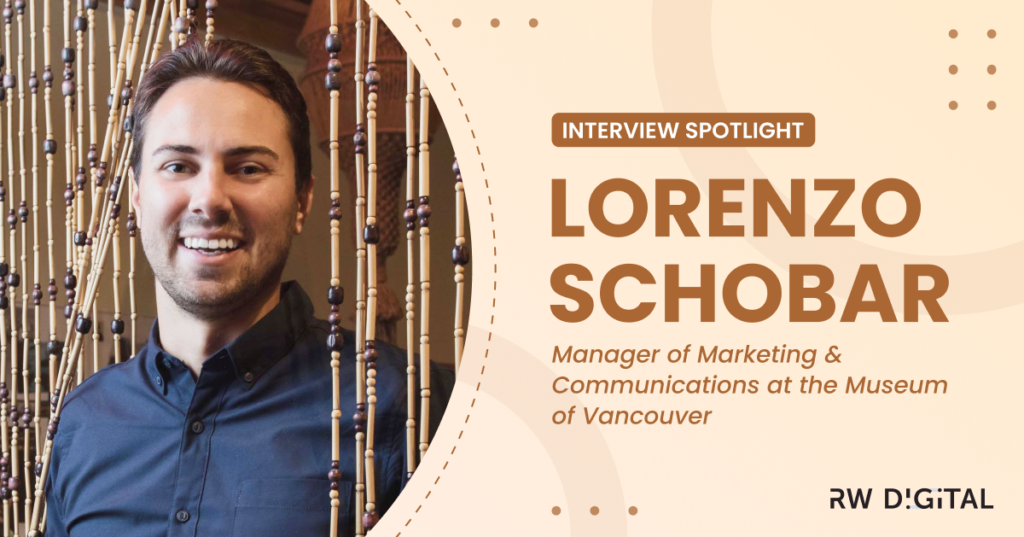Marketing Interview with Lorenzo Schober, Manager of Marketing and Communications at Museum of Vancouver

How has the current health situation impacted non-profit organizations?
The global pandemic has made major impacts on the museum, non-profit, and arts and culture sectors. As a museum we rely on admissions for one of our main revenue streams, which has been severely impacted since March 2020. At the start of the pandemic our focus shifted from attracting visitors to the physical museum to making and maintaining the institution’s relevance in an online world. Admissions and visitation is slowly coming back and, combined with this new focus on digital engagement, our reach continues to grow.
What opportunities has the current health condition created for the non-profit sector?
The pandemic was in some ways the driving force that pushed marketing and communications professionals to embrace a more holistic digital approach to their strategies. Working for a museum, which traditionally invests a lot of resources in a print and distribution strategy, the pandemic made us shift to digital a lot faster than we had planned and revealed the many opportunities that this presented. Not only were we saving money but we also increased our reach and were able to make data driven decisions.
Another opportunity that came in response to the pandemic was an increase in digital literacy for both the organization and the audiences and communities that we serve. It’s crazy to think that platforms we use on a daily basis – like Zoom, Slack, and Teams – were barely used or even understood by the general public before the pandemic.
What are some marketing trends you foresee in the non-profit sector in the next five years?
I predict that this renewed trust in digital will result in more confidence to explore emerging social media trends that may arise in the next 5 years. Many institutions, which were previously reluctant to explore new social channels, like Tik Tok, Reddit, and Snapchat, have embraced them and been able to capture an entire new audience. I think this trend will continue as new platforms are created and used.
I also see a return to connecting in person, with audiences again as restrictions lifted and public events are allowed to take place. I think event marketing opportunities will allow nonprofits to create experiences that connect the public to their brand and vision in a more nuanced and meaningful way.
What are the top three marketing or business tips you would give to non-profit organizations or small businesses to help them adjust or thrive in the current health situation?
Be adaptive: As we’ve learned over the past 2 years, things change that are out of our control. Your strategies should be flexible and adaptable. You should be able to pivot if needed.
Take advantage of learning opportunities: Constantly seek out educational opportunities to help you stay up to date current and upcoming trends, technologies, and strategies. A great group to keep on your radar is Tech Soup!
Grow your network: The more people you know in the industry the more support you have to bounce ideas off of, partner on initiatives, and collaborate to further your reach and engagement – both online and in person. Think collaboratively not competitively.
What are your top three business books, podcasts, or other resources and why?
Made to Stick by Chip and Dan Heath: A great and easy read on communicating ideas effectively and concisely.
In the News: This book is a must for anyone wanting to get into the PR side of marketing and communications. It’s Canadian based and full of examples of successful and innovative campaigns to draw inspiration from.
The Canadian Press Style Book: Staying up to date on Canadian media style guides is helpful and necessary when drafting Media Releases or any form of communication with the media. Having this book on hand helps you stay ahead of the game.

Lorenzo Schober
Lorenzo has an extensive background in marketing within the non-profit and cultural sectors, working on building promotional partnerships, driving awareness, and creating engaging and thought provoking content. The world of marketing and communications is constantly evolving as new technologies, practices and trends take off and become available. Rather than viewing this as a challenge he sees the opportunity to constantly learn and adapt. He has been managing the Marketing and Communications department at the Museum of Vancouver since August 2018 and is focused on taking the brand, content, stories, and messaging behind MOV beyond its walls and into the city.

